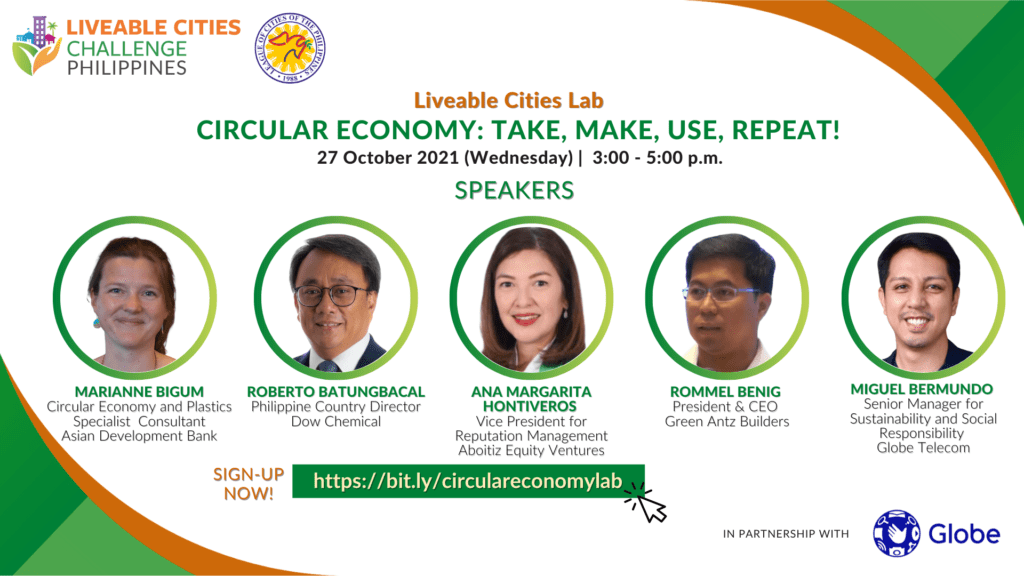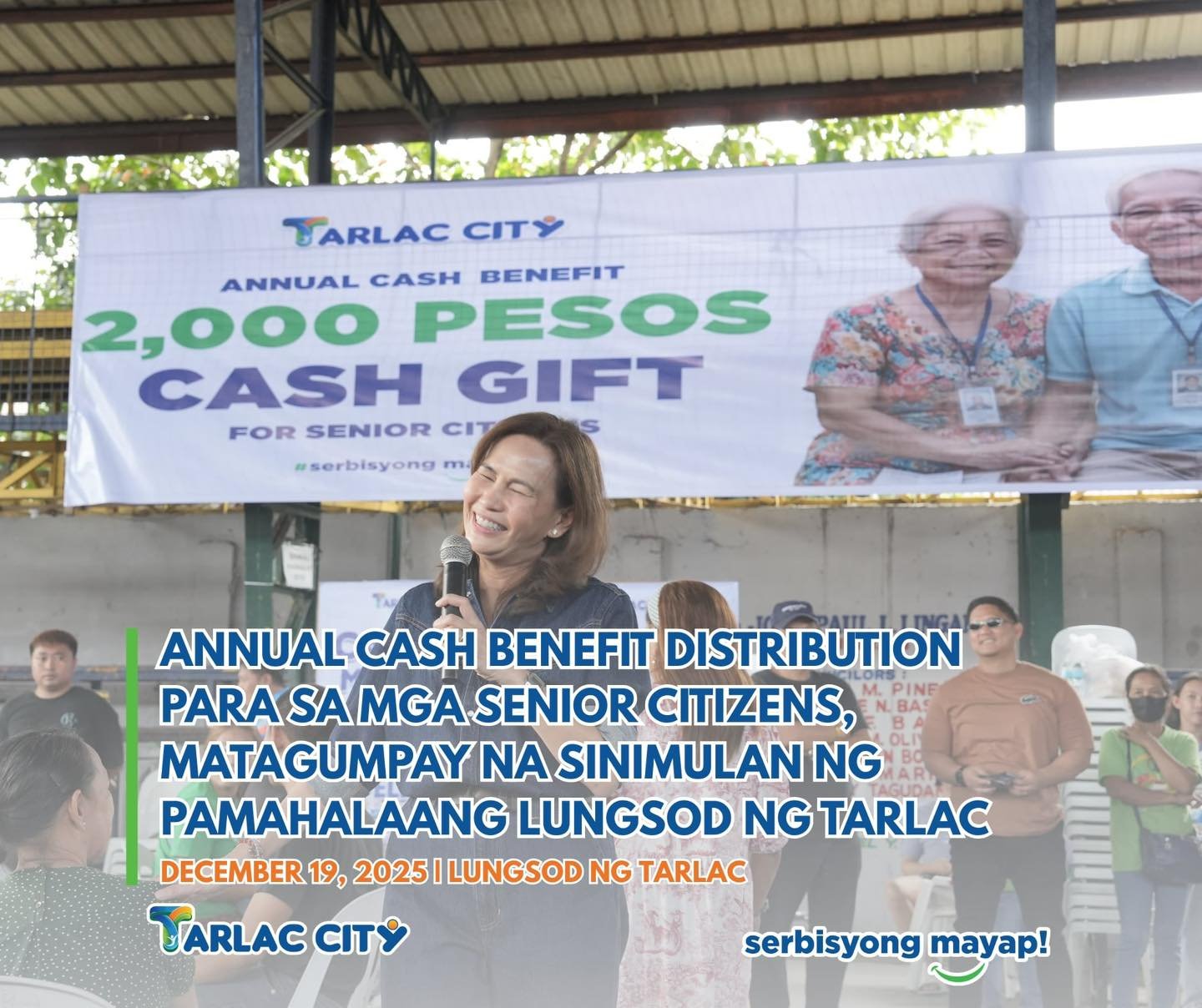With the increasing volume of waste being generated and leaked into water sources and the environment, it has become necessary for companies to transition into a more sustainable model where products and processes, especially for plastics, are designed for circularity rather than linear production.
According to a recent World Bank study, the Philippines generates a staggering 2.7 million tons of plastic waste yearly, an estimated 20 percent of which ends up in the ocean. This is primarily due to unsustainable production, consumption and insufficient solid waste management infrastructure. Much of our existing environmental concerns today are attributed to the linear economy, which follows the take-make-dispose scheme. It is a resource intensive approach and assumes an infinite availability of raw materials from the environment.
“Circular economy: Take, Make, Use, Repeat!” was the topic of the latest Liveable Cities Lab webinar spearheaded by the Liveable Cities Challenge Philippines and the League of Cities of the Philippines, in partnership with Globe. The program aims to equip cities with knowledge and insights for designing better solutions for their communities.
Globe is among the companies that collaborate with Green Antz to properly dispose and process single-use plastic waste within its office premises. Clean and dry plastics are shredded and brought to the Green Antz facility in Arca South, Taguig, for further processing and conversion to eco-bricks and eco pavers. The company also avoids the usage of single-use plastic in its headquarters.
“Circularity is in the heart of UN Sustainable Development Goal No. 12, which is about reducing waste through reduction, recycling, and reuse. It also talks about sound waste management through the lifecycle. In Globe, we have embarked on an employee education campaign called WasSUP (‘Wag Sa Single-Use Plastic) that advocates a zero-waste lifestyle and tackles the impacts of single-use plastics on the environment,” said Miguel Bermundo, Globe Senior Manager for Sustainability Integration.
Adopting a circular model will enable waste minimization at scale. This process starts with design, production, and distribution until the product reaches the user. It also includes collection for recycling after use and re-insertion of the product into the system as a raw material. The main focus of this model is to maintain the added value of a material while eliminating waste as best as possible.
Marianne Bigum, Circular Economy and Plastics Specialist Consultant of the Asian Development Bank (ADB), pointed out the need to go beyond cleanup to stop plastics from entering the environment. She noted the importance of product design and policies that promote the reuse of recyclable materials.
“Can we have a delivery model that doesn’t use single-use plastics? Can we have products that last longer? That can be repaired? That can be recycled? Can we use less material but obtain the same functionality? Can we have less over-packaging?,” are just some of the questions she raised during the event.
Meanwhile, Ana Margarita Hontiveros, Aboitiz Equity Ventures Vice President for Reputation Management, shared how the company’s WOW (Wealth Out of Waste) Program encourages a circular flow of materials across all business units and affiliates through waste management and resource efficiency.
“We’ve begun to look at waste this way: that perhaps 99% of waste from our company operations may be either totally recyclable or reusable. This means that the material may possibly have a solution or that we may have a partner who can make something with that material,” she said.
Green Antz Builders has created a whole ecosystem institutionalizing the circular economy model in the country. It is a product, technology, and solutions development firm that uses waste as a resource.
“We partner with big corporations and local governments to identify things that are difficult to recycle, such as plastic waste, and we sit down and try to develop new products and new building materials out of them. We help other companies keep their waste away from landfills,” said Rommel Benig, Green Antz President and CEO.
Likewise, Roberto Batungbacal, Philippine Country Director of Dow Chemical, said that on top of innovations and investments in recycling, people must be educated about the plastic waste situation.
He said Dow has entered into a partnership to develop a digital module for plastic sustainability education. Its objective is to train the youth to understand the issues of plastic sustainability, how to mitigate it, and be part of the solution.
“This module will be developed in the Philippines. There are a lot of solutions globally, but we need to understand the solutions that are right for us,” he said.
Bigum stressed the necessity of determining the sources of local plastic pollution, identifying the stakeholders to collaborate with to address the issue, and prioritizing actions. The goals are to reduce the unnecessary use of plastic and disposable items and support the local transition to a circular economy.
She also recommended supporting innovations and investments in the reuse and recycling of plastics to protect the environment and generate economic savings.
“Whenever we invest in reuse and recycling, we create less waste. That means less waste for solid waste management. And that is very important in societies where you want to be spending tax money on a lot of better things. If we can design out the waste, we can use that money for something else,” she said.
As a purpose-driven company, Globe supports the 10 UN Global Compact principles and contributes to 10 UN Sustainable Development Goals including UN SDG No. 12 which calls for sustainable consumption and production.
To know more about Globe, visit www.globe.com.ph.













